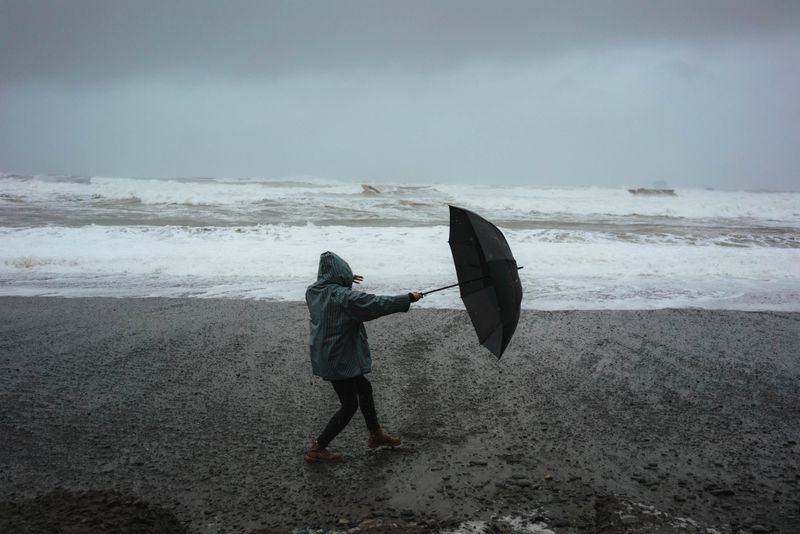Extreme Weather Patterns: Australia Bakes in Spring Heatwave, While US Hit by 14 Storms
In recent weeks, temperatures in Australia have soared to record-breaking levels, as the country experiences a spring heatwave. The Bureau of Meteorology has warned that temperatures may rise as high as 16C above the seasonal average in inland areas of South Australia, New South Wales, and Victoria.
Impacts in Australia
The city of Sydney has already experienced temperatures of 34.2C, which is more than 12C higher than the average for September. Monday and Tuesday are projected to bring even higher temperatures, with a possibility of reaching 16C above the seasonal average. These extreme temperatures are expected to continue throughout the week.
Forecasters are raising concerns about the long-term effects of this heatwave, predicting drier and warmer conditions than average for much of Australia over the summer. These conditions are attributed to the strengthening of an El Niño weather event, which increases the risk of extreme weather phenomena such as wildfires and droughts.
Implications for Australia
The intensified heatwave and the potential for extreme weather events pose a significant threat to Australia’s environment, infrastructure, and public health. Wildfires, in particular, can have devastating consequences, destroying natural habitats, causing property damage, and endangering lives.
It is crucial for authorities in Australia to prepare for the potential risks associated with these extreme weather patterns. This includes implementing effective strategies for fire prevention, public education about heat-related illnesses, and ensuring adequate resources for emergency response efforts.
14th Atlantic Storm in the US
In the United States, the National Hurricane Center has recently named its 14th storm of the Atlantic hurricane season, Tropical Storm Nigel. While Nigel currently poses no immediate threat of landfall, there is a possibility that its remnants could impact the weather in the UK later this week.
It is essential for communities in the potential path of Nigel to stay informed about the storm’s progression and follow official advice from local authorities. Preparation measures, such as securing outdoor objects, stocking up on supplies, and understanding evacuation routes, should be taken to ensure the safety of individuals and property.
Extreme Weather in South America
South America is also experiencing significant weather extremes. The state of Rio Grande do Sul in Brazil is facing further bouts of heavy rain this week, with cumulative rainfall totals of about 150-200mm possible by the end of the week. This follows recent torrential rain and strong winds that caused severe flooding, displacing thousands of people and resulting in weather-related fatalities.
Efforts must be made to improve infrastructure and disaster preparedness in highly vulnerable areas. Early warning systems, flood control measures, and sustainable land management practices can help mitigate the adverse impacts of heavy rainfall and prevent loss of life and property damage.
Conclusion
Extreme weather events, such as heatwaves, storms, and flooding, are becoming increasingly common around the world. They pose significant challenges to communities, governments, and the environment. To address these challenges effectively, it is crucial to prioritize climate change mitigation and adaptation strategies.
Investments in renewable energy, sustainable land management practices, and resilient infrastructure can help reduce greenhouse gas emissions, lessen the severity of weather events, and protect vulnerable communities.
Moreover, international collaboration and information sharing can play a crucial role in preparing for and responding to extreme weather patterns. Countries must work together to develop early warning systems, share best practices in disaster management, and support each other during times of crisis.
As individual citizens, it is important to stay informed and take necessary precautions when extreme weather events are predicted. This includes following official guidance, preparing emergency kits, and supporting efforts to reduce our carbon footprint.
As the climate continues to change, proactive measures and unified action are essential to mitigate the adverse impacts of extreme weather events and create a more sustainable future for all.

<< photo by Dziana Hasanbekava >>
The image is for illustrative purposes only and does not depict the actual situation.
You might want to read !
- Extreme Climate Extremes: Australia’s Scorching Spring and America’s Chilling Surprise
- Australia: Battling a Record-Breaking Spring Heat Wave
- Searching for love: A guide to Married At First Sight UK’s premiere and scheduling
- “The Rise of Vincent Norrman: A Surprising Triumph at the Irish Open”
- Great North Run Faces Stormy Challenge: Met Office Issues Thunderstorm Warning
- The Battle of Football Titans: Streaming and Telecast Options for Germany vs Japan
- Battle of the Titans: A Clash of Cricket Powerhouses – Pakistan vs Nepal Asia Cup 2023
- The Clash of Argyle vs Southampton: A Guide to Live Viewing Options
- “Examining Lampedusa: Ursula von der Leyen and Giorgia Meloni’s Eye-Opening Journey”




